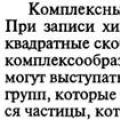Experiment on the theme of space with flour. Experiments for children: creating space at home
Before the start of the thematic week, show your child a photo or presentation about the planets, the solar system, space, and read a thematic book.
- Making a rocket for space travel. A rocket can be made from chairs, pillows, boxes, cardboard, bottles, drawn, molded from plasticine, laid out from counting sticks, cubes, construction sets.
Here are some examples of “Rocket” crafts:




- Play preparing an astronaut for a flight.
The suit check begins. Does the helmet fit comfortably on your head? (Turns, head tilts to the right, left, forward, backward, circular rotations of the head).
An astronaut can move through space using a device placed in a backpack on his back. We check how tightly the backpack is held behind your back. (Circular movements, raising and lowering the shoulders).
Are the numerous zippers and buckles fastened well? (Turns and tilts of the body to the right, left, forward, backward, circular movements of the body, bends towards the feet).
Do the gloves fit snugly on your hands? (Rotational movements with the hands extended forward at chest level, alternating and simultaneous swings of the arms, raising the arms up in front of oneself with alternate bending and extension of the hands, lowering them down through the sides, also alternately bending and straightening the hands).
How does the radio work? Doesn't it act up? (Half squats, jumping on two legs in place).
Are your boots too tight? (Walking in a circle on toes, heels, outer and inner feet, toe-off, side gallop to the right, left, single file step).
Is the spacesuit’s “heating system” okay? Is it easy to breathe in it? (Inhale - arms up, exhale - arms down).
- Launch the rocket.
Place a paper rocket on a cocktail straw and blow into the straw so that the rocket flies up:
Inflate a rocket balloon and tape a cocktail tube to it. Stretch the thread across the room and thread it through the tube. Now release the ball. The air will begin to come out of it, and the ball will fly.

- Getting to know the planets solar system, you can depict them in different ways- mold from salt dough or plasticine, draw with prints of cut potatoes or a cork lid, line with buttons or plasticine, make a mobile from cardboard or felt figures.

We made this drawing: we painted a starry sky by splashing white paint on black paper using a brush. Each planet separately, cut out and glued them onto the starry sky.

The moon can be drawn like this. Cut a circle out of cardboard, draw circles - craters - on it with wax crayons, and then paint over the entire Moon with watercolors.
Lantern "Constellations". Draw constellations on black cardboard, make holes in the places where the stars are located. Glue the resulting cards onto paper cupcake tins, place them on a flashlight and tie them with thread. Now light a flashlight in a dark room and point it at the wall to create a projection of the constellation.
First you just need to tell the baby that the Earth rotates around its axis and around the Sun, and this is very important. If it suddenly stopped, then life on it would cease: in one hemisphere it would become unbearably hot, and in the other everything would freeze, since the Sun would remain only on one side. Nature has a saving pattern - a daily 24-hour cycle of rotation around its axis. At night the planet manages to cool down a little, and during the day it warms up. Therefore, animals, plants and people can live peacefully and rejoice.
Let's try to reproduce the daily cycle at home, using an experiment for children. We will need a tangerine, a long stick and a candle. The time for conducting the experiment is no earlier than 21.00, so that dusk deepens and it is more interesting.
Experiments for children: tangerine planet Earth
1. Take a tangerine, it will play the role of our planet. In shape it is even a little similar to the Earth, as if flattened at the poles, that is, having the shape of an ellipse. Draw a little man on the skin of a tangerine. It will conventionally indicate the place where the child is.
2. Turn off the light and light a candle - our “Sun”. Place the candle on the table - stable, preferably in a candlestick or special stand.
.jpg)
3. Pierce the tangerine with a long stick, trying not to damage the slices. The stick is an imaginary earth's axis.
.jpg)
4. We bring the tangerine to the candle. Does the flame illuminate only one half of the fruit? So the Sun illuminates one hemisphere. You can tilt the stick slightly - the earth's axis is also tilted. The light falls on the drawn man. And where it is dark, it is night.
.jpg)
5. Now turn the stick with the tangerine so that the other half is illuminated by the flame. So the Earth rotates around its axis, and day gives way to night. Now let the baby, if he wants, repeat the experiment from beginning to end on his own.
.jpg)
Explanation of the experiment for children
The earth is constantly rotating around its axis (like we turned our tangerine). Therefore, either sunlight falls on the planet or it does not. The mandarin turned around its “axis”, and the light from the flame fell on it selectively: first one half was illuminated, then the other. Everything is like in nature.
Interesting experiments for children at home will allow you to lure your child into an interesting activity, as well as stimulate his cognition and desire to learn new things. Various experiments can be carried out from the moment when the child is able to perceive information or at least carefully observe the process. The optimal option for the simplest experiments is the age of 2 years, after which, following the growth of the child, you can complicate the experiments and involve your child in helping.
Modern science for children and parents allows you to use available materials to conduct various experiments at home. Children in the world of science will be able to better learn all the features of what is happening around them, as well as learn a lot of useful and interesting things for themselves. Science through the eyes of children will take on a completely different look, and simple and funny manipulations carried out during all procedures will certainly interest your child, and he will be happy to take part.
Simple science: experiences and experiments for children
Experiments for children aged 5-7 years will be the optimal solution for a great time with your baby. Begin school years and vaccinating with the help of various interesting “tricks” will be a good solution. Entertaining science carried out at home opens up a completely different world for a child, in which seemingly simple things turn into something unimaginable.
Simple scientific activities for children of different ages will allow your child to better understand the characteristics of different substances, their combinations and will arouse a healthy interest in learning new things, but for now we bring to your attention 6 experiments that can be carried out at home.
Chemical experiments for children – important point, because you can not only discover something new for your child, but also explain the peculiarities of behavior with different substances and the precautions that should be observed. We present to your attention 3 chemical experience, which can be done at home.
Non-Newtonian fluid
A fairly simple experiment that requires only water and starch. You can use any color of food coloring to add color. It is necessary to mix water with starch in a ratio of 1 to 1. The result is a substance that, in its calm form, retains all the characteristics of water, but when struck or attempted to break, it acquires characteristics more characteristic of a solid body.

Turning milk into a cow
An interesting experiment using milk and vinegar. Milk should be slightly warmed in the microwave or on the stove, without bringing to a boil. After this, add vinegar to the container with milk and begin to actively mix. After some time, clots begin to form, consisting of casein, a protein found in cow's milk. If there is a large accumulation of these clots, you should strain the liquid, and collect the collected casein clots into one, from which you can sculpt a figurine of a cow or any other object. After drying the product, after a few days you get a durable toy made of natural material with hypoallergenic characteristics.

"Elephant Toothpaste"
An impressive experiment that evokes a sea of positive emotions and delight in the child. To carry it out you will need hydrogen peroxide (6%), dry yeast, liquid soap, food coloring and some water. To get the effect, you need to add yeast to a mixture of water, soap and peroxide. The exothermic reaction caused by this will lead to an instant expansion of the resulting mixture, which will immediately flow out of the container like a fountain. To keep your home clean, it is better to conduct this experiment outside, because the height of the jet can reach several meters.

However, chemicals are not the only thing you can use to please your children. There are also experiments for children in such fields of science as physics. We have prepared 3 of the simplest ones especially for you.
Leaky package
To carry out the experiment, all you need is a regular bag, a little water and a few sharp pencils. You need to fill the bag with water and tie it tightly. After this, the moment of true surprise for your children comes when, having completely pierced the bag with a pencil, water will not flow from it. This is due to the fact that polyethylene is a fairly elastic material and can envelop a pencil, preventing water from leaking out.

Frozen soap bubble
To implement this idea, you will need a regular soap bubble and suitable weather conditions (preferably -15 degrees). The child will be able to observe how quickly an ordinary bubble replaces its state of aggregation, freezing and taking on a completely different appearance.

color tower
All you need is water, sugar and various food colorings. By mixing water and sugar in different proportions, you get mixtures of different densities, which allows them not to mix with each other in one vessel, thus creating a tower of different colors.

You can also learn a lot of interesting things by watching the program simple science, exciting experiments for children, videos of which we have already prepared for you.
Valentina Valerievna Sayasova
I bring to your attention several experiments that we did with children when studying the topic « Space» .
1. Experience "Why does a rocket fly":
Let's take a balloon and inflate it, but don't tie it, but squeeze it with our fingers.
There is air in the ball, what will happen if we let go of the ball? It will fly correctly, it will fly like a rocket up and forward. Of course, the rocket is not inflated with ordinary air, but with a flammable substance. When burned, this substance turns into gas, which escapes from the rocket and pushes it forward.
2. Experience "Why is the Sun small":
It seems to us that the sun is very small and the Earth is large. But that's not true. The sun is huge. For example, if you take a soccer ball behind the Sun, our planet will be the size of a pinhead!
Now go to the window (or standing on the street, put your finger in front of you and look at someone) (or anything) into the distance, for example a person. It seems smaller than our finger! Is it true! But it only seems! We know that a finger is smaller than a person. But why? Man is far from us, and the Sun is very, very, very far from us. And we see him small.
3. Experience "Day Night".
Why is it day in one part of the planet and night in the other? You can take a globe or a ball, or you can become planet Earth yourself. Stand with your back to the switched on table lamp (or flashlight) in a dark room. The light from the lamp falls on your back, here the Sun illuminates the planet and it is day on this half of the Earth.

And on the other side is night. Now we are slowly turning towards the Sun Lamp (since our planet revolves around itself) and where there was night, day came and vice versa.

Literature.
Galpershtein L. Ya. My first encyclopedia. - M. ROSMEN. -2003.
(Publishing house "Mann, Ivanov and Ferber") invites parents to organize a real Cosmonautics Day for their children with amazing space experiments. We bet that all the boys and girls who took part in them will want to become astronauts?
"Orbital Movement"
Space is like a rubber film. Various objects cause it to bend and deform. The greater the mass of the object, the deeper the depression on the film. When a smaller object (such as a planet) moves past a larger one (such as a star), it can become trapped in a depression around it - the gravitational field. The smaller object "rolls" in the depression the same way a ball rolled in the depression of a sheet, thanks to gravity.
Why don't planets and stars collide with each other when they are in a cavity? If the planets are moving fast enough, they will not roll down to the lowest point of the depression, but will circle the edge around the star. Scientists call this focus "orbital motion."
Experiment “Space Cavities”
Did you know that there are holes in space too?
Carry out this experiment to see with your own eyes how the cosmic depressions work.
Let your friends stretch the sheet out. Place a jar of jam in its center. Does the sheet sag under the weight of the can, creating a depression?
Now, without removing the jar, throw a tennis ball onto the sheet. What's happening? Surely the ball rolls into a depression, closer to the can. This is how gravity works!
HOW IS THIS POSSIBLE?
Gravity is the force that attracts objects towards each other. The greater the mass of an object, the stronger the force of attraction. Massive objects - planets, stars - bend the fabric of the Universe, just as a jar of jam causes the fabric to bend.
The heavier the object in the center of the sheet, the higher the “gravitational force” and the faster the ball will roll to the center.
For example, a pebble in the center of a sheet will not cause the ball to move noticeably: it is too light and does not bend the fabric much. It’s the same in space: bodies with low mass do not affect the movements of other bodies.
"Creating Orbit"
Thanks to the force of gravity, planets move around stars along a specific path called an orbit. Create a semblance of an orbit using a sheet and a ball.
This time, don't throw the ball onto the sheet, but let it roll around the jar. If the ball moves around the circle fast enough, you will see it follow the same path several times before it slows down and rolls towards the can. This path is the orbit. Since there is almost no friction in space, it takes a very long time for objects to slow down enough to leave orbit.
"Black holes"
Black holes form when a neutron star—one that has shrunk to become small and dense (think of a star the mass of the sun shrunk to the size of a city like Moscow)—continues to shrink. If you get sucked into a black hole, the part of your body that goes in first, such as your feet, will be affected by gravity with more force than the part that gets there last, such as your head. You will begin to stretch!
If you fall into a black hole in a certain way, there is a chance that you will not disintegrate into particles. Perhaps you will fly out the other side and find yourself in another universe!
How are pencil and space related?
Did you know that there is a neutron star inside every pencil? To release it, you need to draw a line. Pencil lead is actually a type of carbon called graphite. Graphite is made up of interlocking and stacked carbon atoms. If you divide this stack into layers one atom thick, you get a substance called graphene. A neutron star also contains carbon.
Imagine: every mark you make with a pencil has stellar properties!
 What is the initial form?
What is the initial form? Amino acid and nc test for self-test work on the topic of amines and amino acids
Amino acid and nc test for self-test work on the topic of amines and amino acids Hydrogen bonding The most important oxidizing and reducing agents
Hydrogen bonding The most important oxidizing and reducing agents